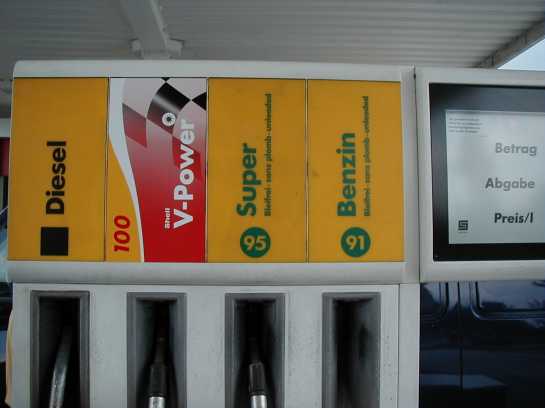|
Gas
Quality - Octane Rate
The 2CV needs good quality high-octane fuel. Most modern cars have an
injection system where the electronic motor management compensates for
a bad gas quality. Probes sense how the engine burns the fuel and if
the engine starts pinging. To compensate for these problems caused by
low quality gas, the computer optimizes the timing and mixture so the
engine can still operate at its best possible performance despite the
bad gas quality. This is why you find a comparable lousy gas quality
in the US. Modern cars just don't let you feel the problems. Some
years ago the highest octane rate we found in the US was 89. Today you
can buy 91 octane fuel at most gas stations, some even have 94 octane
in their premium quality gas. Another quality problem is a high level
of methanol. Most brands add up to 10% methanol to the gas. Experience
show that the 2CV doesn't really like this. I don' know of damages to
the engine from this but the power and performance go down
considerably.
Especially in the Midwest they use high Methanol levels. Mostly the
methanol level is posted somewhere at the pump.
In the 2CV User Manual Citroën requires 97-99 octane for the 2CV
(This is for the 602cc M28/1 engine A06/635). In Europe this
requirement is no problem since the octane rates are considerably
higher than here. In Germany the regular unleaded gas has 91 octane,
super gas has 95 octane and supreme reaches 100 octane (See photo).
All these values are minimum - so quality brands deliver an even
higher octane rate. All 2CV engines with single barrel carburetor need
the highest octane rate. Engines with double barrel carburetor came in
2 versions. Citroën produced an engine with better emission
values only for the German market. This engine was the A06/664. Citroën
reduced the compression on this type to reach the better emission
standard. Instead of a compression ratio of 8.5:1 (In the M28/1
A06/635), the A06/664 had only 7.9:1. This reduced the power marginal
- instead of 29HP this engine delivered only 28HP. The difference is
hardly noticeable but caused by the lower compression, the engine
needs only 91 octane.

Leaded
or Unleaded Gas
The other big question is if the 2CV can run on unleaded gas. When
leaded gas was banned in Europe many years ago, a big discussion
started. Especially in the UK 2CV owners were involved in heated
discussions weather or not to use unleaded gas. Citroën went the
easy way. They simply said that all their cars built after a certain
year (Which I don't remember) can be run on unleaded gas.
To answer this question, we have to look into the function of lead.
In the old days lead was added for two reasons. It boosted the octane
level - which of course is accomplished today by other additives, and
as a lubricant/buffer for the valves. Whenever a valve closes, it
smashes back onto the valve seat. This requires a tempered valve and a
tempered valve seat to make them last. In the old days engine blocks
and cylinder heads were made from steel. The valve seat was just
milled into the head, so the valve seat couldn't be tempered. A buffer
was needed to dampen the impact of the valve onto its seat. The lead
additive performed this function. Without the lead the valve seat
would suffer. That's why old style engines need a lead additive.
The 2CV however was always produced with an aluminum engine block and
cylinder head. Aluminum could never withstand the impact of a tempered
steel valve, that's why Citroën always integrated tempered steel
rings as valve seats into the cylinder head. Now both sides are
tempered, so the lead became obsolete.
So the answer is: The 2CV needs high octane fuel but no lead. If no
high octane fuel is available you should use an octane booster. When
it comes to which brand to choose - we figured big differences between
the different brand names. In Europe there is usually no difference,
here in the US there is a big difference. Our personal favorite brand
is Chevron. The 2CV behaves well with this fuel. The worst gas we ever
had was Arco. The engine was coughing and sputtering, almost as if it
was firing on only one cylinder. It started in 3 different 2CVs right
after we filled up and ended right after we refilled later with
Chevron. Other brands may not lead to such spectacular results but you
can still fell a loss in power.
Other good brands are Texaco, Shell and Amoco. We always try to use
these brands when we travel. |